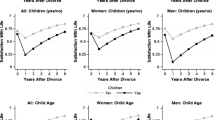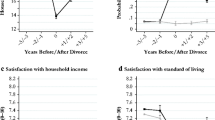Abstract
Scholars identified a negative relationship between assets and divorce decades ago, but the mechanisms behind this relationship remain unknown. Using data from the National Survey of Families and Households (N = 4,721 couples), this study compared three mechanisms that might link assets and divorce. Non-proportional Cox hazard models indicated that two of the three mechanisms explained the relationship between assets and divorce. Wives’ marital satisfaction and their perceptions of their hypothetical post-divorce standard of living completely mediated the relationship between assets and divorce. The relationship between assets and divorce was not related to husbands’ characteristics.

Similar content being viewed by others
References
Allison, P. D. (1995). Survival analysis using the SAS system: A practical guide. Cary, NC: SAS Institute.
Baron, R. M., & Kenny, D. A. (1986). The moderator-mediator distinction in social psychological research: Conceptual, strategic, and statistical considerations. Journal of Personality and Social Psychology, 51, 1173–1182.
Bianchi, S. M., Subaiya, L., & Kahn, J. R. (1999). The gender gap in the economic well-being of nonresident fathers and custodial mothers. Demography, 36, 195–203.
Biddlecom, A. E., & Kramarow, E. A. (1998). Household headship among married women: The roles of economic power, education, and convention. Journal of Family and Economic Issues, 19, 367–382.
Blossfeld, H.-P., & Rohwer, G. (2002). Techniques of event history modeling: New approaches to causal analysis (2nd ed.). Mahwah, NH: Lawrence Erlbaum Associates.
Booth, A., Johnson, D. R., White, L. K., & Edwards, J. N. (1986). Divorce and marital instability over the life course. Journal of Family Issues, 7, 421–442.
Buunk, B. P., & Van Yperen, N. W. (1991). Referential comparisons, relational comparisons, and exchange orientation: Their relation to marital satisfaction. Personality and Social Psychology Bulletin, 6, 709–717.
Caputo, R. K. (2003). Assets and economic mobility in a youth cohort, 1985–1997. Families in Society, 84, 51–62.
Cherlin, A. J. (2004). The deinstitutionalization of American marriage. Journal of Marriage and Family, 66, 848–861.
Coleman, M., & Ganong, L. H. (1992). Financial responsibility for children following divorce and remarriage. Journal of Family and Economic Issues, 13, 445–455.
Conger, R. D., Conger, K. J., Elder, G. H., Jr., Lorenz, F. O., Simons, R. L., & Whitbeck, L. B. (1993). Family economic stress and adjustment of early adolescent girls. Developmental Psychology, 29, 206–219.
Conger, R. D., Ge, X. J., & Lorenz, F. O. (1994). Economic stress and marital relations. In R. D. Conger & G. H. Elder (Eds.), Families in troubled times (pp. 187–203). New York: Aldine de Gruyter.
Daniels, K. C., Rettig, K. D., & delMas, R. (2006). Alternative formulas for distributing parental incomes at divorce. Journal of Family and Economic Issues, 27, 4–26.
Dew, J. P. (2007). Two sides of the same coin? The differing roles of assets and consumer debt in marriage. Journal of Family and Economic Issues, 28, 89–104.
Edin, K. (2001). What do low-income single-mothers say about marriage? Social Problems, 47, 112–133.
England, P., & Farkas, G. (1986). Households, employment, and gender: A social, economic, and demographic view. New York: Aldine.
Fincham, F. D., & Beach, S. R. H. (1999). Conflict in marriage: Implications for working with couples. Annual Review of Psychology, 50, 47–77.
Finke, M. S., & Pierce, N. L. (2006). Precautionary savings behavior of maritally stressed couples. Family and Consumer Sciences Research Journal, 34, 223–240.
Fletschner, D., & Klawitter, M. (2005). Yours, mine, and ours: How married couples hold their savings. Paper presented at the Annual Conference of the Association for Public Policy Analysis and Management, Washington DC.
Galligan, R. J., & Bahr, S. J. (1978). Economic well-being and marital stability: Implications for income maintenance programs. Journal of Marriage and the Family, 40(2), 283–290.
Gerner, J. L., Montalto, C. P., & Bryant, W. K. (1990). Work patterns and marital status change. Journal of Family and Economic Issues, 11, 7–21.
Gudmunson, C. G., Beutler, I. V., Israelsen, C. L., McCoy, J. K., & Hill, E. J. (2007). Linking financial strain to marital instability: Examining the roles of emotional distress and marital interaction. Journal of Family and Economic Issues, 28, 357–376.
Hao, L. (1996). Family structure, private transfers, and the economic well-being of families with children. Social Forces, 75, 269–292.
Hawkins, D. N., & Booth, A. (2005). Unhappily ever after: Effects of long-term, low-quality marriages on well-being. Social Forces, 84, 451–471.
Heimdal, K. R., & Houseknecht, S. K. (2003). Cohabiting and married couples’ income organization: Approaches in Sweden and in the United States. Journal of Marriage and Family, 65, 525–538.
Hirschl, T. A., Altobelli, J., & Rank, M. R. (2003). Does marriage increase the odds of affluence? Exploring the life course probabilities. Journal of Marriage and Family, 65, 927–938.
Johnson, M. P. (1991). Commitment to personal relationships. In W. H. Jones & D. W. Perlman (Eds.), Advances in personal relationships (Vol. 3, pp. 117–143). London: Jessica Kingsly.
Johnson, M. P., Caughlin, J. P., & Huston, T. L. (1999). The tripartite nature of marital commitment: Personal, moral, and structural reasons to stay married. Journal of Marriage and the Family, 61, 160–177.
Levinger, G. (1976). A socio-psychological perspective on marital dissolution. Journal of Social Issues, 32, 21–47.
Levinger, G. (1965). Marital cohesiveness dissolution: An integrative review. Journal of Marriage and the Family, 27, 19–28.
Light, A., & Ureta, M. (2004). Living arrangements, employment status, and the economic well-being of mothers: Evidence from Brazil, Chile, and the US. Journal of Family and Economic Issues, 25, 301–334.
Liker, J. K., & Elder, G. H., Jr. (1983). Economic hardship and marital relations in the 1930s. American Sociological Review, 48, 343–359.
Locke, H. J. (1951). Predicting adjustment in marriage: A comparison of a divorced and a happily married group. New York: Henry Holt.
McKeever, M., & Wolfinger, N. H. (2001). Reexamining the economic costs of marital disruption for women. Social Science Quarterly, 82, 202–217.
Miller, R. S. (1997). Inattentive and contented: Relationship commitment and attention to alternatives. Journal of Personality and Social Psychology, 4, 758–766.
Morgan, L. A., Kitson, G. C., & Kitson, J. T. (1992). The economic fallout from divorce: Issues for the 1990s. Journal of Family and Economic Issues, 13, 435–443.
Muntaner, C., Eaton, W. W., Diala, C., Kessler, R. C., & Sorlie, P. D. (1998). Social class, assets, organizational control and the prevalence of common groups of psychiatric disorders. Social Science and Medicine, 42, 2043–2053.
Nye, F. I. (1979). Choice, exchange, and the family. In W. R. Burr, R. Hill, F. I. Nye, & I. L. Reiss (Eds.), Contemporary theories about the family (Vol. 2, pp. 1–41). New York: The Free Press.
Nye, F. I. (1982). The basic theory. In F. I. Nye (Ed.), Family relationships: Rewards and costs (pp. 13–31). Beverly Hills, C.A: Sage Publications.
Pollak, R. A. (1985). A transaction cost approach to families and households. Journal of Economic Literature, 23, 581–608.
Previti, D., & Amato, P. R. (2003). Why stay married: Rewards, barriers, and marital stability. Journal of Marriage and Family, 65, 561–573.
Raudenbush, S. W., & Bryk, A. S. (2002). Hierarchical linear models: Applications and data analysis methods. Thousand Oaks, CA: Sage Publications.
Sabatelli, R. M. (1999). Marital commitment and family life transitions: A social exchange perspective on the construction and deconstruction of intimate relationships. In W. H. Jones & J. M. Adams (Eds.), Handbook of interpersonal commitment and relationship stability. New York: Plenum Press.
Sanchez, L., & Gager, C. T. (2000). Hard living, perceived entitlement to a great marriage, and marital dissolution. Journal of Marriage and Family, 62(3), 708–722.
Schaninger, C. M., & Buss, W. C. (1986). A longitudinal comparison of consumption and finance handling between happily married and divorced couples. Journal of Marriage and the Family, 48, 129–136.
Schmidt, L., & Sevak, P. (2006). Gender, marriage, and asset accumulation in the United States. Feminist Economics, 12, 139–166.
Smock, P. J., Manning, W. D., & Gupta, S. (1999). The effect of marriage and divorce on women’s economic well-being. American Sociological Review, 64, 794–812.
Smock, P. J., Manning, W. D., & Porter, M. (2005). Everything’s there except money: How money shapes decisions to marry among cohabitors. Journal of Marriage and Family, 67, 680–696.
Thibault, J., & Kelley, H. H. (1959). The social psychology of groups. New York: Wiley.
Tichenor, V. J. (1999). Status and income and gendered resources: The case of marital power. Journal of Marriage and Family, 61, 638–650.
Townsend, N. W. (2002). The package deal: Marriage, work, and fatherhood in men’s lives. Philadelphia: Temple University Press.
Trzcinski, E. (1996). Effects of uncertainty and risk on the allocation of time and married women. Journal of Family and Economic Issues, 17, 327–350.
Waite, L. J., & Gallagher, M. (2000). The case for marriage: Why married people are happier, healthier, and better off financially. New York: Doubleday.
Winkler, A. E., McBride, T. D., & Andrews, C. (2005). Wives who outearn their husbands: A transitory or persistent phenomenon for couples? Demography, 42, 523–535.
Zagorsky, J. L. (2003a). Marriage and divorce’s impact on wealth. Journal of Sociology, 41, 406–424.
Zagorsky, J. L. (2003b). Husbands’ and wives’ view of the family finances. Journal of Socio-Economics, 32, 127–146.
Zelizer, V. A. (1994). The social meaning of money. New York: Basic Books.
Acknowledgements
The author would like to thank Steve Nock and Brad Wilcox for their helpful comments on previous drafts of this study. A grant from the Social Trends Institute and from the Witherspoon Institute supported the author’s efforts in this research. All analyses and interpretations are the authors’ sole responsibility and may not necessarily reflect the grant-making institutions’ views.
Author information
Authors and Affiliations
Corresponding author
Rights and permissions
About this article
Cite this article
Dew, J. The Gendered Meanings of Assets for Divorce. J Fam Econ Iss 30, 20–31 (2009). https://doi.org/10.1007/s10834-008-9138-3
Published:
Issue Date:
DOI: https://doi.org/10.1007/s10834-008-9138-3




